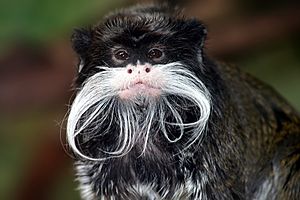Tamarin facts for kids
Quick facts for kids Tamarins |
|
|---|---|
 |
|
| Emperor tamarin (Saguinus imperator) | |
| Scientific classification |
|
| Kingdom: | Animalia |
| Phylum: | Chordata |
| Class: | Mammalia |
| Order: | Primates |
| Suborder: | Haplorhini |
| Infraorder: | Simiiformes |
| Family: | Callitrichidae |
| Genus: | Saguinus Hoffmannsegg, 1807 |
| Type species | |
| Saguinus ursula Hoffmannsegg, 1807
|
|
| Species | |
|
13 species, see text |
|
| Synonyms | |
|
|
The tamarins are squirrel-sized New World monkeys from the family Callitrichidae in the genus Saguinus. They, together with the saddle-back tamarins, are the first offshoot in the Callitrichidae tree, and therefore are the sister group of a clade formed by the lion tamarins, Goeldi's monkeys and marmosets.
Contents
Description
Different tamarin species vary considerably in appearance, ranging from nearly all black through mixtures of black, brown and white. Mustache-like facial hairs are typical for many species. Their body size ranges from 13 to 30 cm (5.1 to 11.8 in) (plus a 25-to-44 cm-long (9.8-to-17.3 in) tail) and they weigh from 220 to 900 grams (7.8 to 31.7 oz). Tamarins differ from marmosets primarily in having lower canine teeth that are clearly longer than the incisors. In captivity, tamarins can live for up to 18 years.
Distribution
Tamarins range from southern Central America through central South America, where they are found in northwestern Colombia, the Amazon basin, and the Guianas.
Behavior and reproduction
Tamarins are inhabitants of tropical rainforests and open forest areas. They are diurnal and arboreal, and run and jump quickly through the trees. Tamarins live together in groups of up to 40 members consisting of one or more families. More frequently, though, groups are composed of just three to nine members.
Tamarins are omnivores, eating fruits and other plant parts as well as spiders, insects, small vertebrates and bird eggs.
Gestation is typically 140 days, and births are normally twins. The adult males, subadults, and juveniles in the group assist with caring for the young, bringing them to their mother to nurse. After approximately one month the young begin to eat solid food, although they aren't fully weaned for another two to three months. They reach full maturity in their second year. Tamarins are almost exclusively polyandrous.
Cottontop tamarins (Saguinus oedipus) breed cooperatively in the wild. Cronin, Kurian, and Snowdon tested eight cottontop tamarins in a series of cooperative pulling experiments. Two monkeys were put on opposite sides of a transparent apparatus containing food. Only if both monkeys pulled a handle on their side of the apparatus towards themselves at the same time would food drop down for them to obtain. The results showed that tamarins pulled the handles at a lower rate when alone with the apparatus than when in the presence of a partner. Cronin, Kurian, and Snowdon concluded from this that cottontop tamarins have a good understanding of cooperation. They suggest that cottontop tamarins have developed cooperative behaviour as a cognitive adaptation.
Predators
While tamarins spend much of their day foraging, they must be on high alert for aerial and terrestrial predators. Due to their small size compared to other primates, they are an easy target for predatory birds, snakes, and mammals.
Taxonomy
The first classification of Saguinus tamarins contained ten different species, further divided into 33 morphotypes based on facial pelage. A later classification into two clades was based on variations in dental measurements. The latest classification postulates fifteen species with no subspecies. A genetic review in 2016 revealed that the oldest species groups first began diverging 11–8 million years ago (considerably earlier than the divergence between Callithrix, Cebuella and Mico), leading the authors to move the saddle-back tamarins to a separate genus, Leontocebus. Other authors argued that the mystax group of tamarins is distinct enough to be classified in the subgenus Tamarinus.
Classification
- Genus Saguinus
- S. midas group
- Red-handed tamarin, Saguinus midas
- Black tamarin, Saguinus niger
- Saguinus ursula
- S. mystax group
- Moustached tamarin, Saguinus mystax
- Spix's moustached tamarin, Saguinus mystax mystax
- White-rump moustached tamarin, Saguinus mystax pluto
- Red-capped tamarin, Saguinus pileatus
- White-lipped tamarin, Saguinus labiatus
- Emperor tamarin, Saguinus imperator
- Moustached tamarin, Saguinus mystax
- S. bicolor group
- Pied tamarin, Saguinus bicolor
- Martins's tamarin, Saguinus martinsi
- Martin's bare-face tamarin, Saguinus martinsi martinsi
- Ochraceus bare-face tamarin, Saguinus martinsi ochraceus
- S. oedipus group
- Cotton-top tamarin or Pinché tamarin, Saguinus oedipus
- Geoffroy's tamarin, Saguinus geoffroyi
- White-footed tamarin, Saguinus leucopus
- S. inustus group
- Mottle-faced tamarin, Saguinus inustus
- S. midas group
See also
 In Spanish: Tamarinos para niños
In Spanish: Tamarinos para niños

